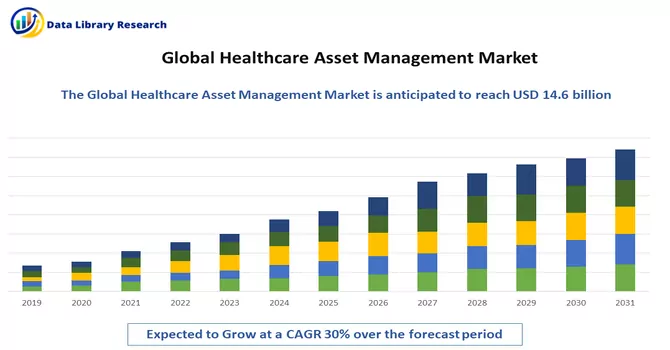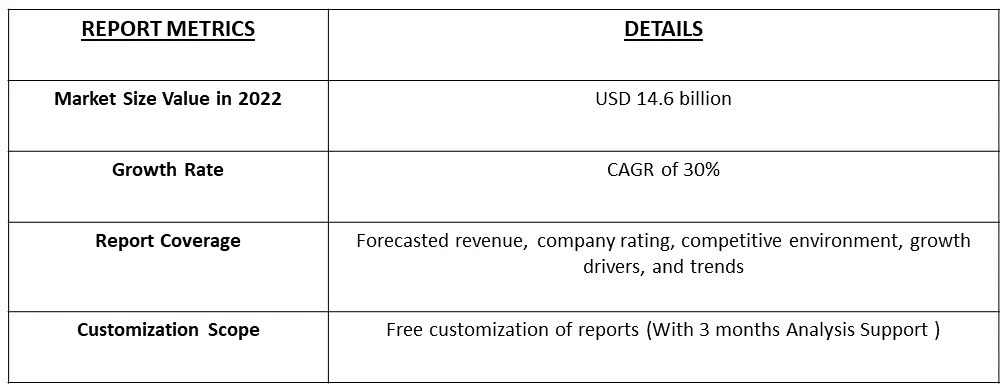The healthcare asset management market is currently valued at USD 14.6 billion in the year 2022 and is expected to register a CAGR of 30% over the forecast period, 2023-2030.

Get Complete Analysis Of The Report - Download Free Sample PDF
Healthcare asset management is a systematic and cost-effective strategy to plan, acquire, operate, and dispose of a healthcare organization's equipment and physical assets. The primary factors that encourage adopting healthcare asset management in healthcare organizations are keeping track of medical devices, high operating costs, time savings, enhanced patient care, higher staff productivity, significant cost savings, and intense maintenance.
The growing focus on existing assets' effective management along with the workforce has propelled numerous facilities of medical worldwide to adopt efficient management technologies and solutions of investments, therefore enlarging market growth of healthcare asset management.
Segmentation:
The Healthcare Asset Management Market is Segmented
By Application
End User :
Geography
The market sizes and forecasts are provided in terms of value (USD million) for all the above segments.

For Detailed Market Segmentation - Download Free Sample PDF
The introduction of Real-Time Location Systems (RTLS) technology has enabled healthcare facilities to track the real-time location of assets such as medical equipment, devices, and even personnel. This enhances asset utilization, reduces search times, and improves overall operational efficiency. Also, healthcare providers were increasingly adopting cloud-based asset management solutions. Cloud platforms offer scalability, accessibility, and data analytics capabilities, which are crucial for managing assets efficiently.
Drivers :
Rising Demand with Increasing Concerns of Drug Counterfeiting
Drug counterfeiting is a global issue that poses significant risks to patient safety. Counterfeit drugs can contain incorrect ingredients, incorrect dosages, or even harmful substances. Healthcare organizations and regulatory bodies are increasingly focused on combatting this problem. The rising concerns of drug counterfeiting have led to increased demand for healthcare asset management solutions that offer track-and-trace, serialization, and authentication capabilities. These solutions help healthcare organizations ensure the safety and authenticity of pharmaceutical products while also enhancing operational efficiency and regulatory compliance. Thus, the segment is expected to witness significant growth over the forecast period.
Technological Advancements
Advancements in technology, including IoT sensors, RFID, and real-time location systems (RTLS), have made asset tracking and management more efficient and cost-effective. These technologies provide real-time visibility into the location and status of assets. For instance, in April 2022 - GE Healthcare and Medtronic announced a collaboration concentrating on the distinct requirements and demand for care at office-based labs (OBLs) and ambulatory surgery centers (ASCs), and the company has partnered with Medtronic to improve productivity, workflow, and clinical outcomes for ASCs and OBLs who engage with GE Healthcare. Thus, due to such advancements, the market is expected to witness significant growth over the forecast period.
Restraints :
Data Privacy Concerns
Data privacy concerns are paramount in the healthcare asset management market due to the sensitive nature of patient data. Healthcare organizations and asset management solution providers must take comprehensive measures to protect patient data privacy, comply with regulations, and ensure that data is handled securely throughout the lifecycle of asset management systems. Thus, the data privacy concerns-related issue may slow down the growth of the studied market over the forecast period.

Get Complete Analysis Of The Report - Download Free Sample PDF
The COVID-19 pandemic had a significant impact on the healthcare asset management market. Hospitals and healthcare facilities experienced unprecedented surges in demand for medical equipment, including ventilators, PPE (Personal Protective Equipment), and other critical supplies. Effective asset management became crucial to ensure these resources were available when and where needed. Also, the pandemic disrupted global supply chains, causing shortages and delays in the delivery of medical equipment and supplies. Asset management solutions were utilized to optimize existing resources, redistribute equipment, and track inventory to address these challenges. In the current scenario, asset management solutions enable remote monitoring and management of medical equipment. This allowed healthcare organizations to perform diagnostics, troubleshoot issues, and make adjustments without the need for physical presence, thus the market is expected to witness significant growth over the forecast period.
Segmental Analysis
Patient Tracking Segment to Dominate the Market Growth Over the Forecast Period
Patient tracking is a critical aspect of healthcare asset management, and it plays a significant role in shaping the healthcare asset management market. Patient tracking solutions, often based on Real-Time Location Systems (RTLS) or RFID technology, help ensure the safety and well-being of patients within healthcare facilities. These systems enable healthcare providers to monitor the real-time location of patients, reducing the risk of adverse events and thus the segment is expected to witness significant growth over the forecast period.
North America to Dominate the Market Growth Over the Forecast Period
The availability of robust healthcare infrastructure has driven the demand for hospital asset management solutions, making their rapid implementation feasible. North America has been at the forefront of adopting IT infrastructure, with a penetration rate of 89.4% of the population, which has contributed to the widespread adoption of asset management solutions in the healthcare sector. Furthermore, North America is a significant player in the global pharmaceutical industry, accounting for over 40% of its market share. The growing recognition of the advantages of implementing asset management systems in healthcare is expected to result in increased demand for these solutions in the future. Therefore, the region's expanding pharmaceutical industry is a driving force behind the growth of the healthcare asset management market. In addition, the market is poised for development due to the increasing utilization of Real-Time Location Systems (RTLS) for asset management and the integration of Internet of Things (IoT) technology for patient tracking, asset monitoring, staff location, and workflow optimization. Patient tracking, in particular, is of utmost importance for hospitals to ensure the safety and well-being of patients, and the adoption of RTLS technology, specifically Wi-Fi RFID combined technology, is proving to be a valuable method for tracking mobile patients in specific areas within North America. Furthermore, the presence of key industry players such as IBM Corporation, GE Healthcare, Tyco International, and Infor in the region not only ensures competitive costs but also provides customers with a wide range of options.
The competition in the market is high as a significant market share lies with the major market players. To provide an appropriate solution, developers must have a deeper understanding of the market's innovation process. It also fosters strong cooperation among healthcare stakeholders during development and customization to meet the end user's demands. The leading companies involved in the Healthcare Asset Management Market include:
Recent Development:
1. March 2022 - Crothall Healthcare's Healthcare Technology Solutions (HTS) division acquired ABM's clinical engineering organization. The Clinical Engineering group of ABM will be under the control of Crothall's Healthcare Technology Solution business, which will use its knowledge and expertise to enhance operations, as the entire lifecycle of medical devices in a hospital is managed and overseen by Crothall Healthcare.
2. March 2022 - Sodexo teamed up with University Hospitals to offer comprehensive primary care and community-based services. Sodexo aimed to provide a range of services under this arrangement, including resource and construction management, technical control over healthcare, patient diet, retail food, and management of resources.
Q1. What is the current Healthcare Asset Management Market size?
The healthcare asset management market is currently valued at USD 14.6 billion.
Q2. What is the Growth Rate of the Healthcare Asset Management Market?
Healthcare Asset Management Market is expected to register a CAGR of 30% over the forecast period.
Q3. Which region has the largest share of the Healthcare Asset Management Market? What are the largest region's market size and growth rate?
North America has the largest share of the market . For detailed insights on the largest region's market size and growth rate request a sample here
Q4. Which are the major companies in the Healthcare Asset Management Market?
IBM Corporation, GE Healthcare, Zebra Technologies Corporation & CenTrak Inc. are some of the major companies in the Healthcare Asset Management Market.
Data Library Research are conducted by industry experts who offer insight on industry structure, market segmentations technology assessment and competitive landscape (CL), and penetration, as well as on emerging trends. Their analysis is based on primary interviews (~ 80%) and secondary research (~ 20%) as well as years of professional expertise in their respective industries. Adding to this, by analysing historical trends and current market positions, our analysts predict where the market will be headed for the next five years. Furthermore, the varying trends of segment & categories geographically presented are also studied and the estimated based on the primary & secondary research.
In this particular report from the supply side Data Library Research has conducted primary surveys (interviews) with the key level executives (VP, CEO’s, Marketing Director, Business Development Manager and SOFT) of the companies that active & prominent as well as the midsized organization
FIGURE 1: DLR RESEARH PROCESS

Extensive primary research was conducted to gain a deeper insight of the market and industry performance. The analysis is based on both primary and secondary research as well as years of professional expertise in the respective industries.
In addition to analysing current and historical trends, our analysts predict where the market is headed over the next five years.
It varies by segment for these categories geographically presented in the list of market tables. Speaking about this particular report we have conducted primary surveys (interviews) with the key level executives (VP, CEO’s, Marketing Director, Business Development Manager and many more) of the major players active in the market.
Secondary ResearchSecondary research was mainly used to collect and identify information useful for the extensive, technical, market-oriented, and Friend’s study of the Global Extra Neutral Alcohol. It was also used to obtain key information about major players, market classification and segmentation according to the industry trends, geographical markets, and developments related to the market and technology perspectives. For this study, analysts have gathered information from various credible sources, such as annual reports, sec filings, journals, white papers, SOFT presentations, and company web sites.
Market Size EstimationBoth, top-down and bottom-up approaches were used to estimate and validate the size of the Global market and to estimate the size of various other dependent submarkets in the overall Extra Neutral Alcohol. The key players in the market were identified through secondary research and their market contributions in the respective geographies were determined through primary and secondary research.
Forecast Model
